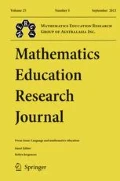Abstract
Australian eighth-grade mathematics lessons were shown by the 1999 TIMSS Video Study to use a high proportion of problems of low procedural complexity, with considerable repetition, and an absence of deductive reasoning. Using definitions from the Video Study, this study re-investigated this ‘shallow teaching syndrome’ by examining the problems on three topics in nine eighth-grade textbooks from four Australian states for procedural complexity, type of solving processes, degree of repetition, proportion of ‘application’ problems and proportion of problems requiring deductive reasoning. Overall, there was broad similarity between the characteristics of problems in the textbooks and in the Australian Video Study lessons. There were, however, considerable differences between textbooks and between topics within textbooks. In some books, including the best-selling textbooks in several states, the balance is too far towards repetitive problems of low procedural complexity.
Similar content being viewed by others
References
Ball, D., & Cohen, D. (1996). Reform by the book: What is—or might be—the role of curriculum materials in teacher learning and instructional reform?Educational Researcher, 25(9), 6–8, 14.
Brändström, A. (2005). Differentiated tasks in mathematics textbooks: An analysis of the levels of difficulty. Licentiate Thesis, Luleå University of Technology, Sweden.
Clarke, D., Keitel, C., & Shimizu, Y. (Eds.) (2006).Mathematics classrooms in twelve countries: The insider’s perspective. Rotterdam: Sense Publications.
Herbel-Eisenmann, B. (2007). From intended curriculum to written curriculum: Examining the “voice” of a mathematics textbook.Journal for Research in Mathematics Education, 38(4), 344–369.
Hiebert, J., Gallimore, R., Garnier, H., Givvin, K. B., Hollingsworth, H., Jacobs, J., Chui, A. M-Y., Wearne, D., Smith, M., Kersting, N., Manaster, A., Tseng, E., Etterbeck, W., Manaster, C., Gonzales, P., & Stigler, J. (2003).Teaching mathematics in seven countries: Results from the TIMSS 1999 Video Study. Washington, DC: National Centre for Education Statistics, U.S. Department of Education.
LessonLab (2003a).TIMSS-R video math coding manual: www.llri.org/html/TIMSS/download/TIMSS%201999%20Video%20Coding%20Manual.pdf
LessonLab (2003b). TIMSS 1999 Video Study: Mathematics. Video clip examples.
Love, E., & Pimm, D. (1996). ‘This is so’: A text on texts. In A. Bishop, K. Clements, C. Keitel, J. Kilpatrick, & C. Laborde (Eds.),International handbook of mathematics education, pp. 371–409. Dordrecht, The Netherlands: Kluwer.
Mayer, R. E., Sims, V., & Tajika, H. (1995). A comparison of how textbooks teach mathematical problem solving in Japan and the United States.American Educational Research Journal, 32(2), 443–460.
Pehkonen, L. (2004). The magic circle of the textbook — an option or an obstacle for teacher change. In M. J. Høines & A. B. Fuglestad (Eds.),Proceedings of the 28th conference of the International Group for the Psychology of Mathematics Education (Vol. 1, pp.107–136). Bergen: PME.
Pepin, B., & Haggarty, L. (2001). Mathematics textbooks and their use in English, French and German classrooms: A way to understand teaching and learning cultures.Zentralblatt für Didaktik der Mathematik, 33(5), 158–175.
Schoenfeld, A. (2004). The math wars.Educational Policy, 18(1), 253–286.
Stacey, K. (2003). The need to increase attention to mathematical reasoning. In H. Hollingsworth, J. Lokan, & B. McCrae,Teaching mathematics in Australia: Results from the TIMSS 1999 video study (pp. 119–122). Melbourne: ACER.
Stein, M. K., & Lane, S. (1996). Instructional tasks and the development of student capacity to think and reason: An analysis of the relationship between teaching and learning in a reform mathematics project.Educational Research and Evaluation, 2(1), 50–80.
Author information
Authors and Affiliations
Rights and permissions
About this article
Cite this article
Vincent, J., Stacey, K. Do mathematics textbooks cultivate shallow teaching? Applying the TIMSS Video Study criteria to Australian eighth-grade mathematics textbooks. Math Ed Res J 20, 82–107 (2008). https://doi.org/10.1007/BF03217470
Published:
Issue Date:
DOI: https://doi.org/10.1007/BF03217470




